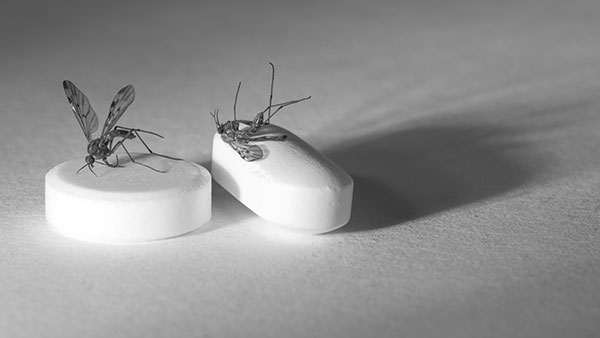In a Disneyesque animated film, one could imagine thousands of anthropomorphized mosquitoes dressed in military fatigues waiting in long lines to be administered their antimalaria pills before they shuffle off to the battlefront. Obviously, in the real world, the method of administration would be much different, but the concept would be similar—dosing mosquitoes with drugs that would prevent them from being susceptible to the malaria parasite. In that vein, investigators from Imperial College London have identified compounds that could prevent malaria parasites from being able to infect mosquitoes, halting the spread of disease.
Findings from the new study were published today in Nature Communications through an article titled “A high throughput screen for next-generation leads targeting malaria parasite transmission.”
Preventing transmission of malaria is a key part of efforts to eliminate the disease. A person can be cured of the disease using drugs that wipe out the replicating form of the parasite, but still carry dormant sexual forms. These are responsible for transferring the parasite to the mosquito when it bites them. Once inside the mosquito, the dormant parasites rapidly mature and then multiply, leaving them ready to infect a new person when the insect feeds again.
![A male malaria parasite sexual stage becoming active -- a process called exflagellation that happens inside the mosquito stomach. [Sabrina Yahiya]](https://genengnews.com/wp-content/uploads/2018/10/180695_web1525416911.jpg)
A male malaria parasite sexual stage becoming active — a process called exflagellation that happens inside the mosquito stomach. [Sabrina Yahiya]
“What we propose is antimalarial drugs that protect mosquitoes, blocking the parasites from continuing their infectious journey, explains senior study investigator Jake Baum, Ph.D., professor in the department of life sciences at Imperial. “By combining such a drug with a conventional antimalarial, we not only cure the individual person but protect the community as well. At the level of the individual person, fighting malaria is a constant battle as parasites become resistant to antimalarial drugs. Since transmission occurs in the mosquito, drugs targeting this process have the added benefit of being naturally much more resistance-proof, which could be essential for eliminating malaria.”
The Imperial team used high-throughput methodologies to screen more than 70,000 compounds and identified six compounds that have the potential to be turned into drugs that block disease transmission. One compound has already been shown to block parasite transmission from mice, but the team is researching all the compounds further to determine exactly how each works, and how they could be adapted as future drugs.
As eluded to in the onset of this article, these drugs could not be given directly to mosquitoes, so they would need to be stable enough to be given to a human and survive being transferred into the mosquito. Determining exactly what each compound is doing could also reveal more about the biology of the transmission process and identify new targets for future drugs.
Plasmodium, the parasite that causes malaria, has a unique and complex lifecycle that alternates between two hosts: humans and mosquitoes. When a person is infected, they will have asexual forms of the parasite in the bloodstream, which cause the symptoms of the disease. However, there will also be male and female sexual forms, which once mature lie dormant in the body.
Since these parasite stages are dormant and not very reactive, they are very difficult to attack with conventional drugs. However, it is these male and female forms that, after sex in the mosquito, create more newly infectious asexual parasites. These gather in the mosquito's salivary glands, ready to pass on malaria to the next unfortunate human.
Yet, while inside the mosquito, the sexual parasites are very active—they are one of the fastest replicating cell types known—making them surprisingly good drug targets. To find compounds that could disrupt the sexual parasites, the team mimicked the conditions inside mosquitoes, fooling parasites into starting sexual development.
Once they found the right conditions, they miniaturized the process so that it could be examined with a microscope. This allowed them to screen thousands of compounds and see if they had any effect on active sexual parasites.
“It took several years to find the right conditions that would stimulate the sexual parasites and to miniaturize the environment, but it was worth it—at our best we were screening 14,000 compounds a week!” exclaims Dr. Baum. “Overall we screened around 70,000 molecules and found only a handful of potent compounds that are both active and safe to use with human cells. It was like finding needles in a haystack.”



